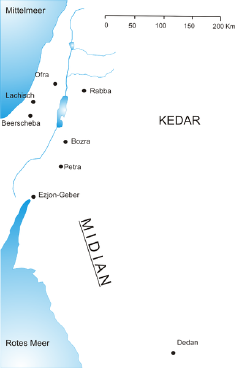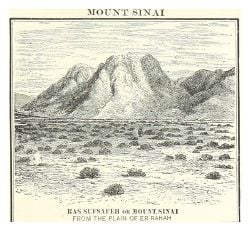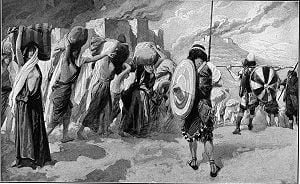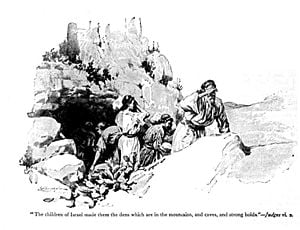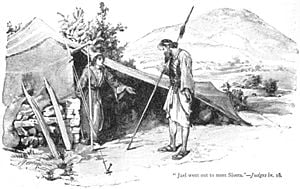Difference between revisions of "Midianite" - New World Encyclopedia
Scott Dunbar (talk | contribs) (Claimed) |
Rosie Tanabe (talk | contribs) |
||
| (27 intermediate revisions by 8 users not shown) | |||
| Line 1: | Line 1: | ||
| − | {{ | + | {{Copyedited}}{{Images OK}}{{submitted}}{{approved}}{{Paid}} |
| − | + | [[File:Midian.png|thumb|250px|Map showing probable Midianite territories]] | |
| + | The '''Midianites''' were a biblical people who occupied territory east of the [[Jordan River]] and the [[Dead Sea]], and southward through the desert wilderness of the [[Arabah]]. They reportedly dominated this territory from roughly the twelfth through the tenth centuries B.C.E. In the biblical account, the Midianites were descended from ''Midian'', a son of [[Abraham]] through his [[concubine]] [[Keturah]] ([[Genesis]] 25:1-6). | ||
| − | + | During the time of the [[Exodus]], their territory apparently also included portions of the [[Sinai Peninsula]]. The land of Midian was also where [[Moses]] spent his 40 years in exile after killing an Egyptian (Exodus 2:11–15). During those years, he married [[Zipporah]], the daughter of [[Jethro]], the priest of Midian. | |
| − | + | When the [[Israelites]] neared [[Canaan]], however, the Midianites came to be seen as enemies after some Midianite women introduced Israelite men to the worship of the local deity [[Baal|Baal-Peor]]. Moses then led a war of [[genocide|extermination]] against them. However, in the [[Book of Judges]], the Midianites were strong enough again to cause serious trouble for the Israelites until the judge [[Gideon]] subdued the Midianites and their [[Amalekite]]s allies. | |
| − | |||
| − | |||
| − | + | Not all of the Midianites, however, were in fact the Israelites' enemies. For example, the Midianite clan known as the [[Kenites]] were allied with the Israelites and eventually merged with the [[Tribe of Judah]]. The heroine of the [[Book of Judges]], [[Jael]], was the wife of a Midianite who lived among the Israelites. | |
| + | {{toc}} | ||
| + | The people of Midian are also mentioned in the [[Qur'an]], where the name appears in Arabic as ''Madyan''. [[Allah]] sent to them the prophet Shoaib, traditionally identified with the biblical [[Jethro]]. Today, the former territory of Midian is located in western [[Saudi Arabia]], southern [[Jordan]], southern [[Israel]], and the Egyptian [[Sinai peninsula]]. | ||
| − | In the [[Book of Genesis]], Midian was the son of [[Abraham]] and [[Keturah]]. | + | ==Origins and location== |
| + | In the [[Book of Genesis]], Midian was the son of [[Abraham]] and [[Keturah]]. Midian's five sons—[[Ephah]], [[Epher]], [[Enoch (son of Midian)|Enoch]], [[Abidah]], and [[Eldaah]]—were the progenitors of the Midianites ([[Genesis]] 25:1–4; I [[Books of Chronicles|Chronicles]] 1:32–33). Their geographical situation is indicated in Genesis as having been to the east of [[Canaan]], as Abraham sent the sons of his concubines, including Midian, eastward (Genesis 25:6). Midianites figure into the story of the Israelites' migration to Israel when they cooperate with Jacob's sons in selling their half-brother Joseph into slavery (Genesis 37:36). | ||
| − | + | From the statement that Moses led the flocks of [[Jethro]], the [[priest]] of Midian, to [[Mount Horeb]] ([[Exodus]] 3:1), it would appear that the Midianites dwelt in the [[Sinai peninsula]], having either migrated there or conquered or settled the area in addition to their eastern possessions. Later, in the period of the [[Kingdom of Israel|Israelite monarchy]], Midian seems to have occupied a tract of land between Edom and [[Paran]], on the way to [[Egypt]] (I [[Books of Kings|Kings]] 11:18). | |
| − | + | Midian is likewise described as in the vicinity of [[Moab]]. The Midianites were beaten by the Edomite king [[Hadad ben Bedad]] "in the field of Moab" ([[Genesis]] 36:35). In the account of the prophet [[Balaam]] it is said that the elders of both Moab and Midian called upon him to curse Israel ([[Book of Numbers|Numbers]] 22:4,7). | |
| − | + | ==Before and during the Exodus== | |
| + | [[File:MACCOUN(1899) p055 MOUNT SINAI.jpg|thumb|250px|right|Traditional site of Mount Sinai, described in the Bible as located in Midian.]] | ||
| + | In [[Exodus]], the land of Midian is introduced as the place to which Moses fled when running away from Pharaoh. There, he encountered [[Jethro]], a Midianite priest, who later became Moses' [[father-in-law]]. Moses thus lived among the Midianites, and it is during this period that he encountered [[Yahweh]] for the first time in the account of the [[burning bush]]. His Midianite wife, Zipporah saved his life by wisely [[circumcision|circumcising]] their son when [[Yahweh]] attempted to kill Moses on the road back to Egypt (Ex. 4:25). Yahweh was apparently a god known to the Midianites, for Jethro offered a sacrifice to Him and shared the feast with elders of Israel (Ex. 18:12). | ||
| − | + | However, toward the close of the 40 years in the wilderness, the Midianites who lived east of the [[Jordan]] felt threatened as the huge force of [[Israelites]] moved through their territory, conquering local kings on their way. Thus, they joined with the [[Moabite]] king Balak to ask the prophet [[Balaam]] to curse the Israelites (Numbers 22). Balaam—who like Jethro honored [[Yahweh]]—famously refused this order and blessed the Israelites instead. Subsequently the Israelites coexisted peacefully with Moabites and Midianites (Numbers 25). However, during this time the Israelites intermarried with Midianite women and adopted religious practices deemed unacceptable to Yahweh, namely worshiping the local deity, [[Baal|Baal-Peor]]. When a plague soon broke out among the Israelites, Moses understood this as a punishment from God. To put an end to the plague, the Israelite priest [[Phinehas]] personally killed a Midianite princess named Cozbi, who had married an Israelite man, impaling both her and her husband with a single spear thrust. Moses was ordered by God to treat the Midianites from then on as enemies (Num. 25). | |
| − | + | One of Moses' last commands from God was to take "vengeance" against the Midianties (Num. 31). He dispatched an army of 12,000 men, under [[Phinehas]]. This force utterly defeated the Midianites and reportedly slew all their males, including their five kings—[[Evi]], [[Rekem]], [[Zur]], [[Hur (Midian)|Hur]], and [[Reba (Midian)|Reba]]. Also put to death was the prophet Balaam, who had earlier blessed Israel but was now blamed for tempting Israel to sin. | |
| − | + | [[Image:Midianite-women.jpg|thumb|300px|Israelite soldiers lead away a Midianite women.]] | |
| − | + | <blockquote>The Israelites captured the Midianite women and children and took all the Midianite herds, flocks and goods as plunder. They burned all the towns where the Midianites had settled, as well as all their camps. They took all the plunder and spoils, including the people and animals, and brought the captives, spoils and plunder to Moses and Eleazar the priest and the Israelite assembly at their camp on the plains of Moab, by the Jordan across from Jericho (Num. 31:9-12).</blockquote> | |
| − | + | This, however was deemed not to be a thorough enough slaughter. Moses asked, "Have you allowed all the women to live?" He then ordered that all the older women be put to death, together with all of the boys, leaving only the [[virgin]] girls alive to become wives of the Israelite soldiers. | |
| − | + | The narrative indicates that each of the five Midianite tribes was governed by its own king, but that all acted together against a common enemy. Some of the Midianites seem to have lived in the fortified towns in the vicinity of [[Moab]] while others lived a nomadic life. The account of Moses' war of extermination against the Midianites, however, appears to be exaggerated, for the Midiantes reappear as a major power several generations later in the time of [[Gideon]]. | |
| − | + | ==During the period of the Judges== | |
| + | [[Image:Israelites-hide-from-Midianites.jpg|thumb|300px|Israelites keep watch for the Midianites who have forced them into hiding.]] | ||
| + | The biblical account of Gideon ([[Judges]] 6-8) indicates that the Midianites were so powerful in the region of the [[Tribe of Manasseh]] that the Israelites there were forced to abandon their fields and take shelter in mountain clefts, [[cave]]s, and strongholds. Together with the Edomite tribe of the [[Amalekite]]s, they harassed the Israelites as far to the west as the Philistine city of Gaza. The Israelites reportedly suffered at the hands of the Midianites for a time period of six years. Midianite raiders destroyed crops and reduced them to extreme [[poverty]] (Judges 6:1–6). | ||
| − | The Midianites | + | The allied army of Midianites and Amalekites encamped in the valley of [[Jezreel]] (Judges 6:33) after having crossed the Jordan. Gideon with his army encamped by the fountain of [[Harod]], the Midianite army being to the north of him. With 300 men, Gideon succeeded in surprising and routing them, and they fled homeward across the Jordan in confusion (Judges 7:1–24). Here, only two Midianite kings ([[Zebah]] and [[Zalmuna]]) and two princes or captains ([[Oreb]] and [[Zeeb]]) are mentioned (Judges 7:25-8:21). This might indicate that only two tribes now bore the name "Midianites," while the remaining three were probably either wiped out or merged with other tribes, including with the Israelites. Midian is stated to have been "subdued before the children of Israel, so that they lifted up their heads no more." (Judges 8:28) |
| − | + | Indeed, aside from allusions to this victory—in [[Psalms]] 83, [[Isaiah]] 9:4 and 10:6, and [[Habbakuk]] 3:7—Midian is not mentioned again in the Hebrew Bible. The apocryphal [[Book of Judith]] (2:26) uses the term "Midianites" as a synonym for "[[Arabia]]ns." | |
| − | The | + | ==The Kenites== |
| − | + | Supporting the idea the Midianites merged with the [[Israelites]] is the story of the Kenites in the first chapter of the [[Book of Judges]]. The [[Kenites]], were the descendants of Jethro, the Midianite priest. According to Judges 1:16: | |
| − | The | + | [[Image:Jael.jpg|thumb|300px|The heroine Jael lures Israel's enemy, Sisera, into her tent.]] |
| + | <blockquote>The descendants of Moses' father-in-law, the Kenite, went up from the City of Palms (Jericho) with the men of [[Judah]] to live among the people of the Desert of Judah in the Negev near Arad.</blockquote> | ||
| + | Later, the wife of a man named Heber the Kenite played a major role in the Israelite victory commemorated in the "Song of Deborah." Heber's wife [[Jael]] lured the [[Canaanite]] commander Sisera into her tent and assassinated him in his sleep. The Bible preserves a lengthy poem describing the event, which declares: "Most blessed of women be Jael, the wife of Heber the Kenite, most blessed of tent-dwelling women" (Judges 5:24). | ||
| − | + | Later, when King Saul is commanded by God to destroy the [[Amalekites]], among whom some of the Kenites dwell, the Kenites are spared by being given a warning to move away from the Amalekites before the slaughter begins (1 Samuel 15:6). | |
| − | The | + | ==In archeology and religious studies== |
| + | Midianites are thought to have been involved together with the Egyptians in mining endeavors at Timna, 30 km north of the Gulf of Eilat, indicating a relatively sophisticated cultural and technological level. The Midianites have been tentatively connected by some scholars with the remnants of the [[Hyksos]] who once ruled Egypt but were later driven out and made their home in the desert. They have also been identified with the people whom the Egyptians called the ''[[Shasu]]''. An Egyptian inscription refers to "''Yhw'' in the land of the Shasu," a people living in what the Bible describes as Midianite territory. This has led to speculation that the Shashu/Midianites may have been early worshipers of [[Yahweh]], the "God of [[Abraham]]." Some consider them as "proto-Israelites," a term referring to various peoples in an around the land of [[Canaan]] who later evolved into or merged with the people of "Israel" (Finkelstein 2002). | ||
| − | + | The biblical account describes the Midianites as worshiping more than one deity, including both [[Baal-peor]] and Yahweh. Both of these deities are likewise described as being worshiped by the Israelites themselves, although [[Baal]] worship was supposedly forbidden to them. Some scholars speculate that the worship of Yahweh may have actually begun among the Midianites and was later adapted by the Israelites, an idea strongly contested by Christian scholars. Supporting this theory is the fact that [[Exodus]] states that God was known as as [[El|El-Shaddai]] by the Israelites until Moses' encounter with Him at Sinai, after first meeting the Midianite priest [[Jethro]] and marrying into his family (Exodus 6:3). | |
| − | |||
| − | |||
| − | |||
| − | |||
| − | |||
| − | |||
| − | |||
| − | |||
==References== | ==References== | ||
| − | + | * Bruce, Frederick Fyvie. ''Israel and the Nations: The History of Israel from the Exodus to the Fall of the Second Temple.'' InterVarsity Press, 1998. ISBN 978-0830815104 | |
| − | * | + | * Burton, Richard F. ''The Land of Midian (Revisited) Two volumes in one''. Echo Library, 2006. ISBN 978-1406801033 |
| + | * Cowart, John L. ''The Priest of Midian'' (fiction). 1st Books Library, 2001. ISBN 978-0759623613 | ||
| + | * Dever, William G. ''What Did the Biblical Writers Know and When Did They Know It?: What Archaeology Can Tell Us About the Reality of Ancient Israel''. Wm. B. Eerdmans Publishing Company, 2002. ISBN 978-0802821263 | ||
| + | * Finkelstein, Israel, ''The Bible Unearthed: Archaeology's New Vision of Ancient Israel and the Origin of Its Sacred Texts''. New York: Free Press, 2002. ISBN 0684869128 | ||
| + | * Grant, Michael. ''The History of Ancient Israel''. NY: Charles Scribner's Sons, 1984. ISBN 0684180812 | ||
| + | * Sawyer, John and David Clines (eds.). "Midian, Moab and Edom: The History and Archaeology of Late Bronze and Iron Age Jordan and North-West Arabia." ''Journal for the Study of the Old Testament'', Supplement Series, No. 24. Sheffield Academic Press, 1983. ISBN 978-0905774480 | ||
| − | == | + | ==External links== |
| − | + | All links retrieved November 9, 2022. | |
| − | |||
| − | |||
| − | |||
| − | |||
| − | |||
| − | |||
| − | |||
| − | |||
| − | |||
| − | |||
| + | * [http://www.jewishmag.com/95mag/timna/timna.htm Timna] ''Archeology in Israel''. | ||
| + | * [https://www.jewishvirtuallibrary.org/timna Archaeology in Israel: Timna] ''Jewish Virtual Library''. | ||
{{Sons of Abraham}} | {{Sons of Abraham}} | ||
[[Category:philosophy and religion]] | [[Category:philosophy and religion]] | ||
| + | [[category:religion]] | ||
{{Credit|127356376}} | {{Credit|127356376}} | ||
Latest revision as of 17:34, 9 November 2022
The Midianites were a biblical people who occupied territory east of the Jordan River and the Dead Sea, and southward through the desert wilderness of the Arabah. They reportedly dominated this territory from roughly the twelfth through the tenth centuries B.C.E. In the biblical account, the Midianites were descended from Midian, a son of Abraham through his concubine Keturah (Genesis 25:1-6).
During the time of the Exodus, their territory apparently also included portions of the Sinai Peninsula. The land of Midian was also where Moses spent his 40 years in exile after killing an Egyptian (Exodus 2:11–15). During those years, he married Zipporah, the daughter of Jethro, the priest of Midian.
When the Israelites neared Canaan, however, the Midianites came to be seen as enemies after some Midianite women introduced Israelite men to the worship of the local deity Baal-Peor. Moses then led a war of extermination against them. However, in the Book of Judges, the Midianites were strong enough again to cause serious trouble for the Israelites until the judge Gideon subdued the Midianites and their Amalekites allies.
Not all of the Midianites, however, were in fact the Israelites' enemies. For example, the Midianite clan known as the Kenites were allied with the Israelites and eventually merged with the Tribe of Judah. The heroine of the Book of Judges, Jael, was the wife of a Midianite who lived among the Israelites.
The people of Midian are also mentioned in the Qur'an, where the name appears in Arabic as Madyan. Allah sent to them the prophet Shoaib, traditionally identified with the biblical Jethro. Today, the former territory of Midian is located in western Saudi Arabia, southern Jordan, southern Israel, and the Egyptian Sinai peninsula.
Origins and location
In the Book of Genesis, Midian was the son of Abraham and Keturah. Midian's five sons—Ephah, Epher, Enoch, Abidah, and Eldaah—were the progenitors of the Midianites (Genesis 25:1–4; I Chronicles 1:32–33). Their geographical situation is indicated in Genesis as having been to the east of Canaan, as Abraham sent the sons of his concubines, including Midian, eastward (Genesis 25:6). Midianites figure into the story of the Israelites' migration to Israel when they cooperate with Jacob's sons in selling their half-brother Joseph into slavery (Genesis 37:36).
From the statement that Moses led the flocks of Jethro, the priest of Midian, to Mount Horeb (Exodus 3:1), it would appear that the Midianites dwelt in the Sinai peninsula, having either migrated there or conquered or settled the area in addition to their eastern possessions. Later, in the period of the Israelite monarchy, Midian seems to have occupied a tract of land between Edom and Paran, on the way to Egypt (I Kings 11:18).
Midian is likewise described as in the vicinity of Moab. The Midianites were beaten by the Edomite king Hadad ben Bedad "in the field of Moab" (Genesis 36:35). In the account of the prophet Balaam it is said that the elders of both Moab and Midian called upon him to curse Israel (Numbers 22:4,7).
Before and during the Exodus
In Exodus, the land of Midian is introduced as the place to which Moses fled when running away from Pharaoh. There, he encountered Jethro, a Midianite priest, who later became Moses' father-in-law. Moses thus lived among the Midianites, and it is during this period that he encountered Yahweh for the first time in the account of the burning bush. His Midianite wife, Zipporah saved his life by wisely circumcising their son when Yahweh attempted to kill Moses on the road back to Egypt (Ex. 4:25). Yahweh was apparently a god known to the Midianites, for Jethro offered a sacrifice to Him and shared the feast with elders of Israel (Ex. 18:12).
However, toward the close of the 40 years in the wilderness, the Midianites who lived east of the Jordan felt threatened as the huge force of Israelites moved through their territory, conquering local kings on their way. Thus, they joined with the Moabite king Balak to ask the prophet Balaam to curse the Israelites (Numbers 22). Balaam—who like Jethro honored Yahweh—famously refused this order and blessed the Israelites instead. Subsequently the Israelites coexisted peacefully with Moabites and Midianites (Numbers 25). However, during this time the Israelites intermarried with Midianite women and adopted religious practices deemed unacceptable to Yahweh, namely worshiping the local deity, Baal-Peor. When a plague soon broke out among the Israelites, Moses understood this as a punishment from God. To put an end to the plague, the Israelite priest Phinehas personally killed a Midianite princess named Cozbi, who had married an Israelite man, impaling both her and her husband with a single spear thrust. Moses was ordered by God to treat the Midianites from then on as enemies (Num. 25).
One of Moses' last commands from God was to take "vengeance" against the Midianties (Num. 31). He dispatched an army of 12,000 men, under Phinehas. This force utterly defeated the Midianites and reportedly slew all their males, including their five kings—Evi, Rekem, Zur, Hur, and Reba. Also put to death was the prophet Balaam, who had earlier blessed Israel but was now blamed for tempting Israel to sin.
The Israelites captured the Midianite women and children and took all the Midianite herds, flocks and goods as plunder. They burned all the towns where the Midianites had settled, as well as all their camps. They took all the plunder and spoils, including the people and animals, and brought the captives, spoils and plunder to Moses and Eleazar the priest and the Israelite assembly at their camp on the plains of Moab, by the Jordan across from Jericho (Num. 31:9-12).
This, however was deemed not to be a thorough enough slaughter. Moses asked, "Have you allowed all the women to live?" He then ordered that all the older women be put to death, together with all of the boys, leaving only the virgin girls alive to become wives of the Israelite soldiers.
The narrative indicates that each of the five Midianite tribes was governed by its own king, but that all acted together against a common enemy. Some of the Midianites seem to have lived in the fortified towns in the vicinity of Moab while others lived a nomadic life. The account of Moses' war of extermination against the Midianites, however, appears to be exaggerated, for the Midiantes reappear as a major power several generations later in the time of Gideon.
During the period of the Judges
The biblical account of Gideon (Judges 6-8) indicates that the Midianites were so powerful in the region of the Tribe of Manasseh that the Israelites there were forced to abandon their fields and take shelter in mountain clefts, caves, and strongholds. Together with the Edomite tribe of the Amalekites, they harassed the Israelites as far to the west as the Philistine city of Gaza. The Israelites reportedly suffered at the hands of the Midianites for a time period of six years. Midianite raiders destroyed crops and reduced them to extreme poverty (Judges 6:1–6).
The allied army of Midianites and Amalekites encamped in the valley of Jezreel (Judges 6:33) after having crossed the Jordan. Gideon with his army encamped by the fountain of Harod, the Midianite army being to the north of him. With 300 men, Gideon succeeded in surprising and routing them, and they fled homeward across the Jordan in confusion (Judges 7:1–24). Here, only two Midianite kings (Zebah and Zalmuna) and two princes or captains (Oreb and Zeeb) are mentioned (Judges 7:25-8:21). This might indicate that only two tribes now bore the name "Midianites," while the remaining three were probably either wiped out or merged with other tribes, including with the Israelites. Midian is stated to have been "subdued before the children of Israel, so that they lifted up their heads no more." (Judges 8:28)
Indeed, aside from allusions to this victory—in Psalms 83, Isaiah 9:4 and 10:6, and Habbakuk 3:7—Midian is not mentioned again in the Hebrew Bible. The apocryphal Book of Judith (2:26) uses the term "Midianites" as a synonym for "Arabians."
The Kenites
Supporting the idea the Midianites merged with the Israelites is the story of the Kenites in the first chapter of the Book of Judges. The Kenites, were the descendants of Jethro, the Midianite priest. According to Judges 1:16:
The descendants of Moses' father-in-law, the Kenite, went up from the City of Palms (Jericho) with the men of Judah to live among the people of the Desert of Judah in the Negev near Arad.
Later, the wife of a man named Heber the Kenite played a major role in the Israelite victory commemorated in the "Song of Deborah." Heber's wife Jael lured the Canaanite commander Sisera into her tent and assassinated him in his sleep. The Bible preserves a lengthy poem describing the event, which declares: "Most blessed of women be Jael, the wife of Heber the Kenite, most blessed of tent-dwelling women" (Judges 5:24).
Later, when King Saul is commanded by God to destroy the Amalekites, among whom some of the Kenites dwell, the Kenites are spared by being given a warning to move away from the Amalekites before the slaughter begins (1 Samuel 15:6).
In archeology and religious studies
Midianites are thought to have been involved together with the Egyptians in mining endeavors at Timna, 30 km north of the Gulf of Eilat, indicating a relatively sophisticated cultural and technological level. The Midianites have been tentatively connected by some scholars with the remnants of the Hyksos who once ruled Egypt but were later driven out and made their home in the desert. They have also been identified with the people whom the Egyptians called the Shasu. An Egyptian inscription refers to "Yhw in the land of the Shasu," a people living in what the Bible describes as Midianite territory. This has led to speculation that the Shashu/Midianites may have been early worshipers of Yahweh, the "God of Abraham." Some consider them as "proto-Israelites," a term referring to various peoples in an around the land of Canaan who later evolved into or merged with the people of "Israel" (Finkelstein 2002).
The biblical account describes the Midianites as worshiping more than one deity, including both Baal-peor and Yahweh. Both of these deities are likewise described as being worshiped by the Israelites themselves, although Baal worship was supposedly forbidden to them. Some scholars speculate that the worship of Yahweh may have actually begun among the Midianites and was later adapted by the Israelites, an idea strongly contested by Christian scholars. Supporting this theory is the fact that Exodus states that God was known as as El-Shaddai by the Israelites until Moses' encounter with Him at Sinai, after first meeting the Midianite priest Jethro and marrying into his family (Exodus 6:3).
ReferencesISBN links support NWE through referral fees
- Bruce, Frederick Fyvie. Israel and the Nations: The History of Israel from the Exodus to the Fall of the Second Temple. InterVarsity Press, 1998. ISBN 978-0830815104
- Burton, Richard F. The Land of Midian (Revisited) Two volumes in one. Echo Library, 2006. ISBN 978-1406801033
- Cowart, John L. The Priest of Midian (fiction). 1st Books Library, 2001. ISBN 978-0759623613
- Dever, William G. What Did the Biblical Writers Know and When Did They Know It?: What Archaeology Can Tell Us About the Reality of Ancient Israel. Wm. B. Eerdmans Publishing Company, 2002. ISBN 978-0802821263
- Finkelstein, Israel, The Bible Unearthed: Archaeology's New Vision of Ancient Israel and the Origin of Its Sacred Texts. New York: Free Press, 2002. ISBN 0684869128
- Grant, Michael. The History of Ancient Israel. NY: Charles Scribner's Sons, 1984. ISBN 0684180812
- Sawyer, John and David Clines (eds.). "Midian, Moab and Edom: The History and Archaeology of Late Bronze and Iron Age Jordan and North-West Arabia." Journal for the Study of the Old Testament, Supplement Series, No. 24. Sheffield Academic Press, 1983. ISBN 978-0905774480
External links
All links retrieved November 9, 2022.
- Timna Archeology in Israel.
- Archaeology in Israel: Timna Jewish Virtual Library.
Credits
New World Encyclopedia writers and editors rewrote and completed the Wikipedia article in accordance with New World Encyclopedia standards. This article abides by terms of the Creative Commons CC-by-sa 3.0 License (CC-by-sa), which may be used and disseminated with proper attribution. Credit is due under the terms of this license that can reference both the New World Encyclopedia contributors and the selfless volunteer contributors of the Wikimedia Foundation. To cite this article click here for a list of acceptable citing formats.The history of earlier contributions by wikipedians is accessible to researchers here:
The history of this article since it was imported to New World Encyclopedia:
Note: Some restrictions may apply to use of individual images which are separately licensed.
